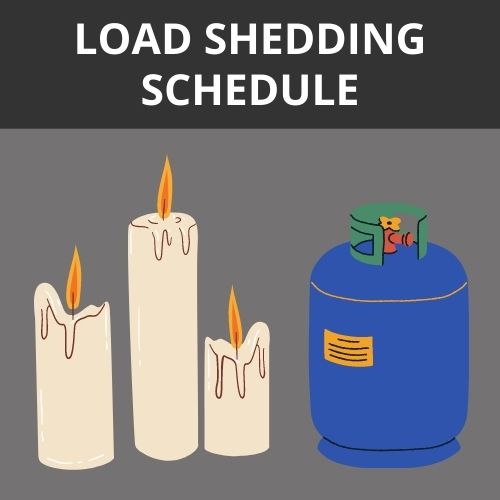Load shedding has become a pervasive problem in Gauteng, causing significant disruptions to businesses and households alike. It refers to the deliberate and temporary interruption of electricity supply to certain areas as a measure to balance the demand and supply of electricity.
Load Shedding Schedule Today in Gauteng
Choose the municipality you’re looking for in Gauteng below to get the load shedding schedule for today.
Load Shedding Stages
Currently in Gauteng, there are 8 stages of load shedding. Keep on reading to learn more about what each of these stages entail.
Stage 1
The first step of the process is referred to as Stage 1. In order to balance the country’s electric grid, Eskom must decrease its energy usage by 1,000 megawatts. This is known as Stage 1 and is accomplished through two-hour power outages over four days or four-hour blackouts over eight days.
Stage 2
In order to conserve 2,000 megawatts on the national grid, Eskom initiates stage 2 load shedding which happens on an eight day cycle, with outages lasting for four hours each, or on a four day cycle with outages lasting two hours at a time.
Stage 3
At stage 3 of load-shedding, the energy requirement necessitates a decrease of 3,000 megawatts from the national grid. Generally, this will mean nine load shedding periods that last for at least four hours over an eight-day period. In some cases, there might be nine two-hour intervals of no electricity over a span of four days.
Stage 4
The fourth stage requires a reduction of up to 4,000 megawatts from the national power grid. This can be accomplished through either twelve four-hour outages spread over a period of eight days or twelve two-hour outages over four days.
Stage 5
When Eskom reaches Stage 5 load shedding, it must cut back up to 5,000 megawatts from the national power grid, leading to South Africans having to endure eight hours of power loss every day. During this stage, those affected can anticipate a minimum of four days with twelve two hour periods without electricity.
Stage 6
In order to avert the potential breakdown of the national electricity grid, Stage 6 load shedding has been instituted by Eskom, which necessitates the shedding of 6,000 megawatts of energy. Furthermore, Eskom may call for additional, unscheduled power outages wherever it is deemed necessary.
It is possible to endure 18 periods of disruption, each up to four-and-a-half hours long, over a four day period or 18 times within an eight day stretch, with each disruption lasting approximately two hours.
Stage 7
Stage 7 load shedding requires Eskom to reduce a total of 7,000 megawatts of electricity. This necessitates the implementation of a four-day plan with the electricity being cut for four hours at a time.
Stage 8
This is the final stage of load shedding and pretty much spells disaster for the country.
Stage 8 load shedding is twice as frequent as stage 4, leading to Eskom cutting off about 8,000 megawatts of power.
As a result, you could be without electricity up to six times in a day, with the outages lasting for a duration of 12 hours, depending on the schedule. An absolute quagmire!

Causes of Load Shedding in Gauteng
There are several factors contributing to load shedding in Gauteng. The primary cause is the mismatch between electricity demand and supply. As the population grows and industries expand, the demand for electricity increases, straining the already constrained power infrastructure.
Additionally, insufficient maintenance and aging power plants further exacerbate the situation. Furthermore, natural disasters, such as storms and flooding, can damage power infrastructure, leading to unplanned outages and the need for load shedding.
Impact of Load Shedding on Businesses and Households
Load shedding has a profound impact on both businesses and households. For businesses, power outages result in significant financial losses due to interrupted operations, lost productivity, and damage to equipment.
It also affects the delivery of essential services, such as healthcare facilities and emergency services. Small businesses, in particular, are severely affected as they may lack backup power sources.
On the other hand, households experience disruptions to daily activities, such as cooking, heating, and lighting. It also compromises the safety and security of homes, especially during night-time load shedding.
Coping Strategies During Power Outages
During load shedding, it is crucial for businesses and households to have effective coping strategies in place. One of the most common practices is the use of backup power sources, such as generators and uninterruptible power supply (UPS) systems.
These provide temporary electricity supply during outages, ensuring the continuity of critical operations. Implementing energy-saving measures, such as using energy-efficient appliances and lighting, can also help reduce electricity consumption during load shedding.
Furthermore, establishing communication channels with utility providers and staying updated on load shedding schedules can assist in better planning and preparation.

Government Initiatives to Address Load Shedding
The South African government acknowledges the severity of the load shedding problem and has implemented various initiatives to address it.
One of the key steps taken is the introduction of the Integrated Resource Plan (IRP), which outlines a long-term vision for the country’s energy mix. The plan emphasises the importance of diversifying energy sources, including a significant focus on renewable energy.
The government has also encouraged independent power producers to enter the market, increasing competition and reducing reliance on a single power utility.
The Role of Renewable Energy
Renewable energy plays a crucial role in reducing the reliance on traditional power sources and mitigating load shedding. Gauteng has abundant renewable energy resources, such as solar and wind.
The government’s Renewable Energy Independent Power Producer Procurement Program (REIPPPP) has attracted significant investments in renewable energy projects. These projects contribute to the national grid and help stabilise the electricity supply.
Additionally, decentralised renewable energy solutions, such as rooftop solar panels, can provide localised electricity generation, reducing the strain on the national grid.
Tips for Managing Electricity Usage During Load Shedding
Managing electricity usage effectively during load shedding can help minimise the impact on businesses and households. It is essential to prioritise electricity consumption and allocate power to critical operations.
This can be achieved by identifying essential equipment and services that require uninterrupted power and implementing load shedding schedules accordingly.
Energy-saving practices, such as turning off non-essential appliances and utilising natural lighting, can also contribute to reducing electricity demand during power outages. Furthermore, educating individuals and businesses about energy-efficient practices and the importance of load shedding preparedness is crucial.
Innovations and Technologies
Innovations and technologies have emerged to mitigate the effects of load shedding and improve resilience. Energy storage systems, such as advanced batteries, enable the storage of excess electricity during non-peak hours for later use during load shedding.
Smart grids and demand response systems allow for better management of electricity demand and supply, optimising the distribution and utilisation of power. Furthermore, microgrid solutions provide localised electricity generation and distribution, reducing the reliance on the main grid during load shedding.
The Future of Load Shedding in Gauteng
While significant efforts are being made to address load shedding in Gauteng, challenges still remain. The country needs to accelerate the implementation of renewable energy projects and invest in upgrading power infrastructure.
Government policies and regulations should support the growth of independent power producers and encourage energy efficiency. The integration of emerging technologies and smart grid solutions will play a vital role in reducing load shedding and ensuring a reliable electricity supply for the future.




